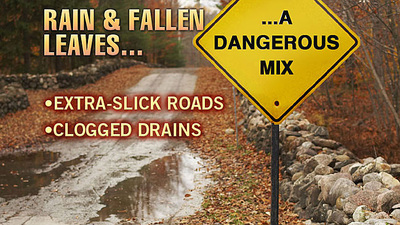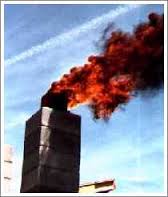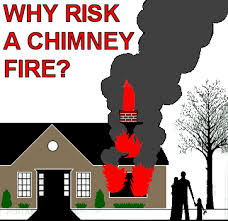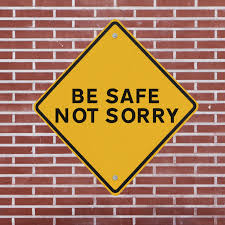As you snuggle in front of a cozy fire or bask in the warmth of your wood stove, you are taking part in a ritual of comfort and enjoyment handed down through the centuries. The last thing you are likely to be thinking about is the condition of your chimney. However, if you don’t give some thought to it before you light those winter fires, your enjoyment may be very short-lived. Why? Dirty chimneys can cause chimney fires, which damage structures, destroy homes and injure or kill people.
No One Welcomes a Chimney Fire
A chimney fire in action can be impressive. Indications of a chimney fire have been described as creating: loud cracking and popping noise : a lot of dense smoke, and an intense, hot smell Chimney fires can burn explosively – noisy and dramatic enough to be detected by neighbors or people passing by. Flames or dense smoke may shoot from the top of the chimney. Homeowners report being startled by a low rumbling sound that reminds them of a freight train or a low flying airplane. However, those are only the chimney fires you know about. Slow-burning chimney fires don’t get enough air or have fuel to be dramatic or visible. But, the temperatures they reach are very high and can cause as much damage to the chimney structure – and nearby combustible parts of the house – as their more spectacular cousins. With proper chimney system care, chimney fires are entirely preventable.
Creosote & Chimney Fires: What You Must Know
Fireplaces and wood stoves are designed to safely contain wood-fuel fires, while providing heat for a home. The chimneys that serve them have the job of expelling the by-products of combustion – the substances produced when wood burns. These include smoke, water vapor, gases, unburned wood particles, hydrocarbon, tar fog and assorted minerals. As these substances exit the fireplace or wood stove, and flow up into the relatively cooler chimney, condensation occurs. The resulting residue that sticks to the inner walls of the chimney is called creosote.
Creosote is black or brown in appearance. It can be crusty and flaky…tar-like, drippy and sticky…or shiny and hardened. Often, all forms will occur in one chimney system. Whatever form it takes, creosote is highly combustible. If it builds up in sufficient quantities – and the internal flue temperature is high enough – the result could be a chimney fire. Certain conditions encourage the buildup of creosote. Restricted air supply, unseasoned wood and, cooler than normal chimney temperatures are all factors that can accelerate the buildup of creosote on chimney flue walls. Air supply may be restricted by closing the glass doors, by failing to open the damper wide enough, and the lack of sufficient make-up air to move heated smoke up the chimney rapidly (the longer the smoke’s “residence time” in the flue, the more likely is it that creosote will form). A wood stove’s air supply can be limited by closing down the stove damper or air inlets too soon or too much. Burning unseasoned wood – because so much energy is used initially just to drive off the water trapped in the cells of the logs– keeps the resulting smoke cooler, than if seasoned wood is used. In the case of wood stoves, overloading the firebox with wood in an attempt to get a longer burn time also contributes to creosote buildup.
How Chimney Fires Hurt Chimneys
Masonry Chimneys
When a chimney fire occur in masonry chimney – whether the flue is an older, unlined type or tile lined to meet current safety codes – the high temperatures at which they burn (around 2000°F) can “melt mortar, crack tiles, cause liners to collapse and damage the outer masonry material”. Most often, thermal shock occurs and tiles crack and mortar is displaced, which provides a pathway for flames to reach the combustible wood frame of the house. This event is extremely dangerous, call 911 immediately.
Pre-fabricated, factory-built, metal chimneys
To be installed in most jurisdictions in the United States, factory built, metal chimneys that are designed to vent wood burning stoves or pre-fabricated metal fireplaces must pass special tests. Most tests require the chimney to withstand flue temperatures up to 2100°F – without sustaining damage. Under chimney fire conditions, damage to these systems still may occur. When pre-fabricated, factory-built metal chimneys are damaged by a chimney fire, they should no longer be used and must be replaced.
Special Effects on Wood Stoves
Wood stoves are made to contain hot fires. The connector pipes that run from the stove to the chimney are another matter. They cannot withstand the high temperatures produced during a chimney fire and can warp, buckle and even separate from the vibrations created by air turbulence during a fire. If damaged by a chimney fire, they must be replaced.
Nine Signs that You’ve Had a Chimney Fire
Since a chimney, damaged by a chimney fire, can endanger a home and its’ occupants and a chimney fire can occur without anyone being aware of them it’s important to have your chimney regularly inspected by a CSIA Certifed Chimney Sweep. Here are the signs that a professional chimney sweep looks for:
- “Puffy” or “honey combed” creosote,Warped metal of the damper, metal smoke chamber connector pipe or factory-built metal chimney, Cracked or collapsed flue tiles, or tiles with large chunks missing, Discolored and/or distorted rain cap, Heat-damaged TV antenna attached to the chimney, Creosote flakes and pieces found on the roof or ground, Roofing material damaged from hot creosote, Cracks in exterior masonry, Evidence of smoke escaping through mortar joints of masonry or tile liners. If you think a chimney fire has occurred, call a CSIA Certified Chimney Sweep® for a professional evaluation. If your suspicions are confirmed, a certified sweep will be able to make recommendations about how to bring the system back into compliance with safety standards. Depending on the situation, you might need a few flue tiles replaced, a new liner system installed or an entire chimney rebuilt. Each situation is unique and will dictate its own solution.
Clean chimneys don’t catch fire. Make sure a CSIA Certified Chimney Sweep inspects your solid fuel venting system annually, and cleans and repairs it whenever needed. Your sweep may have other maintenance recommendations depending on how you use your fireplace or stove. CSIA recommends that you call on CSIA Certified Chimney Sweeps, since they are regularly tested on their understanding of the complexities of chimney and venting system.
The Dangers of Leaves on the Roads
When leaves accumulate on the roadway and become wet, they can get extremely slippery, making the driving conditions similar to driving on ice. If the temperature drops below freezing, the wet leaves will freeze and turn into dangerous icy leaves on the roadway. Besides reducing the car's traction, causing skidding and the possibility of losing control of the vehicle, leaves often cover the painted road markings, making it difficult to know the locations of the lanes.
- Slow down if you are driving on a road covered with leaves, especially when driving around turns. Allow yourself plenty of room to stop in an emergency. Keep a greater distance between you and the car in front of you. Leaves make it difficult to see potholes and bumps in the road. A pile of leaves raked to the side of the road is an inviting place to a child. Children enjoy jumping into the leaf piles or burrowing down into them and hiding. Never drive through a leaf pile. Use caution going around turns and where children are playing. Keep your windshield leaf free to avoid wet leaves getting stuck under the windshield wiper blades. In order to avoid the possibility of a fire hazard from the exhaust system or catalytic converter, never park your vehicle over a pile of leaves. Changing Weather Conditions In many areas, autumn is a damp, wet season. There are many rainy or foggy days and nights. As the temperatures drop, frost often coats the ground at night. When driving in fog, set your headlight to low beam. This setting aims the beam of light down toward the roadway. In the fall as temperatures drop, frost often forms on the roadway, causing hazardous driving conditions. Drive slowly and break gently at overpasses and bridges as these areas frost over more quickly than other roadway surfaces. Be aware of areas where black ice forms on the roadway.
- Yard Work
- Every autumn leaves inevitably will fall, leaving your yard cluttered and in need of clean-up. Consider the following safety tips to prevent injuries while performing yard work.
- Use a rake that is comfortable for your height and strength. Wear gloves or use rakes with padded handles to prevent blisters. Wet leaves can be slippery; wear shoes or boots with slip-resistant soles. Do not overfill leaf bags, especially if the leaves are wet. To avoid back injury, you should be able to carry bags comfortably. Never throw leaves over your shoulder or to the side. The twisting motion required to do so places undue stress on your back. Make sure the engine is off and cool before you begin any maintenance work or refuel your lawnmower.Wear protective gear like goggles and gloves, boots and long pants when mowing. Never mow barefoot or in sandals.Never use your hands or feet to clear debris from under a lawnmower. Use a stick or broom handle instead. Likewise, never touch the blades with your hands or feet, even if the engine is off. The blade can still move and cause serious injury.
- Fire Safty Tips When Burning Leaves
Safety tips:
• Make sure the area around your pile is clear of debris
• Have water and hand tools such as a shovel or rake handy
• Make sure your fire is completely out before leaving it
• Never leave your fire unattended
* Never Burn When Windy
Many don't bother. Dozier estimates 30 percent to 40 percent of wildfires begin with the burning of yard waste.
Do NOT burn manufactured materials such as tires, shingles, plastics, etc. - Halloween Safety
Halloween is a fun-filled time for children, but there are many dangers associated with the holiday unrelated to ghouls, goblins and witches. Parents need to take the necessary precautions to make sure their children remain safe while still having fun by selecting a safe costume and providing children with important instructions before trick-or-treating. Motorists also need to stay especially alert due to the high number of child pedestrians out in communities.






